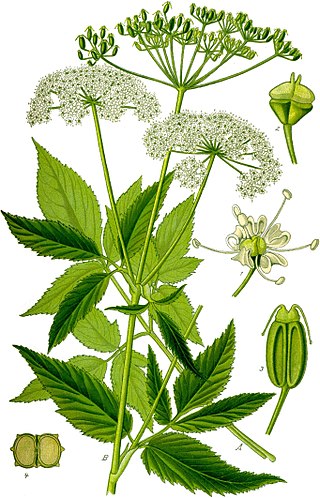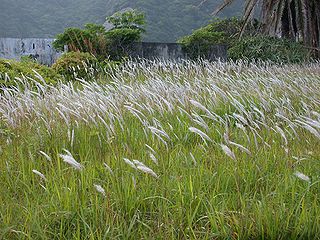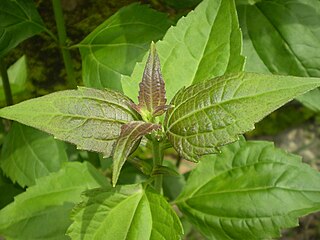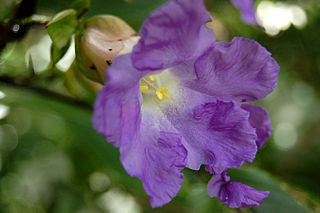
Brisbane Water National Park is a national park on the Central Coast of New South Wales, Australia. The national park is situated 70 kilometres (43 mi) north of Sydney and 12 kilometres (7.5 mi) southwest of Gosford. It consists the Brisbane Water and Mooney Mooney Creek waterways.

Prosopis is a genus of flowering plants in the family Fabaceae. It contains around 45 species of spiny trees and shrubs found in subtropical and tropical regions of the Americas, Africa, Western Asia, and South Asia. They often thrive in arid soil and are resistant to drought, on occasion developing extremely deep root systems. Their wood is usually hard, dense and durable. Their fruits are pods and may contain large amounts of sugar. The generic name means "burdock" in late Latin and originated in the Greek language.

Horton Plains National Park is a national park in the central highlands of Sri Lanka that was designated in 1988. It is located at an elevation of 2,100–2,300 m (6,900–7,500 ft) and encompasses montane grassland and cloud forest. It is rich in biodiversity and many species found here are endemic to the region. It is also a popular tourist destination and is situated 8 kilometres (5.0 mi) from Ohiya, 6 kilometres (3.7 mi) from the world-famous Ohiya Gap/Dondra Watch and 32 kilometres (20 mi) from Nuwara Eliya.

Aegopodium podagraria, commonly called ground elder, is a species of flowering plant in the carrot family Apiaceae that grows in shady places. The name "ground elder" comes from the superficial similarity of its leaves and flowers to those of elder (Sambucus), which is not closely related. Other common names include herb gerard, bishop's weed, goutweed, gout wort, snow-in-the-mountain, English masterwort and wild masterwort. It is the type species of the genus Aegopodium. It is native to Europe and Asia, but has been introduced around the world as an ornamental plant, where it occasionally poses an ecological threat as an invasive exotic plant.

Strobilanthes is a genus of about 350 species of flowering plants in the family Acanthaceae, mostly native to tropical Asia and Madagascar, but with a few species extending north into temperate regions of Asia. Many species are cultivated for their two-lipped, hooded flowers in shades of blue, pink, white and purple. Most are frost-tender and require protection in frost-prone areas. The genus is most famed for its many species which bloom on long cycles of several years, such as Strobilanthes wightii which blooms every thirteen years.

Pilosella officinarum, known as mouse-ear hawkweed, is a yellow-flowered species of flowering plant in the daisy family Asteraceae, native to Europe and northern Asia. It produces single, lemon-coloured inflorescences. Like most hawkweed species, it is highly variable and is a member of a species complex of several dozens of subspecies and hundreds of varieties and forms. It is an allelopathic plant.

Imperata cylindrica is a species of perennial rhizomatous grass native to tropical and subtropical Asia, Micronesia, Melanesia, Australia, Africa, and Southern Europe. It has also been introduced to Latin America, the Caribbean, and the Southeastern United States. It is a highly flammable pyrophyte, and can spread rapidly by colonizing disturbed areas and encouraging more frequent wildfires.

Potentilla reptans, known as the creeping cinquefoil, European cinquefoil or creeping tormentil, is a flowering plant in the family Rosaceae.

Soliva sessilis, one of up to nine species of the genus Soliva, is a low-growing herbaceous annual plant. Its common names include field burrweed, Onehunga-weed, lawn burrweed, lawnweed, jo-jo weed and common soliva. It is one of several plants also known as bindi weed, bindii, or bindi-eye.

Johnson grass or Johnsongrass, Sorghum halepense, is a plant in the grass family, Poaceae, native to Asia and northern Africa. The plant has been introduced to all continents except Antarctica, and most larger islands and archipelagos. It reproduces by rhizomes and seeds.

Chromolaena odorata is a tropical and subtropical species of flowering shrub in the family Asteraceae. It is native to the Americas, from Florida and Texas in the United States south through Mexico and the Caribbean to South America. It has been introduced to tropical Asia, West Africa, and parts of Australia.

Melaleuca quinquenervia, commonly known as the broad-leaved paperbark, paper bark tea tree, punk tree or niaouli, is a small- to medium-sized tree of the myrtle family, Myrtaceae. It grows as a spreading tree up to 20 m (70 ft) tall, with its trunk covered by a white, beige and grey thick papery bark. The grey-green leaves are egg-shaped, and cream or white bottlebrush-like flowers appear from late spring to autumn. It was first formally described in 1797 by the Spanish naturalist Antonio José Cavanilles.

Lantana camara is a species of flowering plant within the verbena family (Verbenaceae), native to the American tropics. It is a very adaptable species, which can inhabit a wide variety of ecosystems; once it has been introduced into a habitat it spreads rapidly; between 45ºN and 45ºS and less than 1,400 metres in altitude.

Verbena bonariensis, the purpletop vervain, clustertop vervain, Argentinian vervain, tall verbena or pretty verbena, is a member of the verbena family cultivated as a flowering annual or herbaceous perennial plant. In USA horticulture, it is also known by the ambiguous names purpletop and South American vervain. For the misapplication "Brazilian verbena" see below.

Cabomba caroliniana, commonly known as Carolina fanwort and various other names, is an aquatic perennial herbaceous plant native to North and South America. Having been a popular aquarium plant, it has been exported around the world, and has become an invasive species in Europe and Australia.

Ageratina adenophora, commonly known as Crofton weed, is a species of flowering plant in the family Asteraceae native to Mexico and Central America. Originally grown as an ornamental plant, it has become invasive into farmland and bushland worldwide. It is toxic to horses, which develop a respiratory disease known as Numinbah horse sickness after eating it.

Lachnagrostis filiformis is a species of grass known by the common names Pacific bent grass, New Zealand wind grass, fairy grass, or blown-grass. It is native to Australia, New Zealand, and other Pacific Islands including New Guinea and Easter Island. While it is found in a wide variety of habitats, it seems particularly invasive in areas with damp soils, such as areas near bodies of water. It has been introduced to southern Africa, the United Kingdom, Taiwan, the southern United States and Mexico.

Strobilanthes callosa(Synonym: Carvia callosa Bremek) is a shrub found mainly in the low lying hills of the Western Ghats, all along the west coast of India. Its standardized Hindi name is maruadona (मरुआदोना) which it is called in the state of Madhya Pradesh where it is also found. In the state of Maharashtra, in the Marathi language, and other local dialects and in the neighboring state of Karnataka, the shrub is locally known as karvi (कारवी), sometimes spelled in English as karvy.

Brachiaria mutica is a species of grass known by the common names para grass, buffalo grass, Mauritius signal grass, pasto pare, malojilla, gramalote, parana, Carib grass, and Scotch grass. Despite its common name California grass, it does not occur in California; it is native to northern and central Africa and parts of the Middle East, where it is cultivated for fodder. It was introduced elsewhere and it is now cultivated throughout tropical regions of the world for this purpose.

Mazus miquelii, commonly known as Miquel's mazus or creeping mazus, is a species of herbaceous perennial groundcover native to Japan and China. Mazus reptans is now considered a heterotypic synonym of M. miquelii, but is still often used in the ornamental plant trade.




















